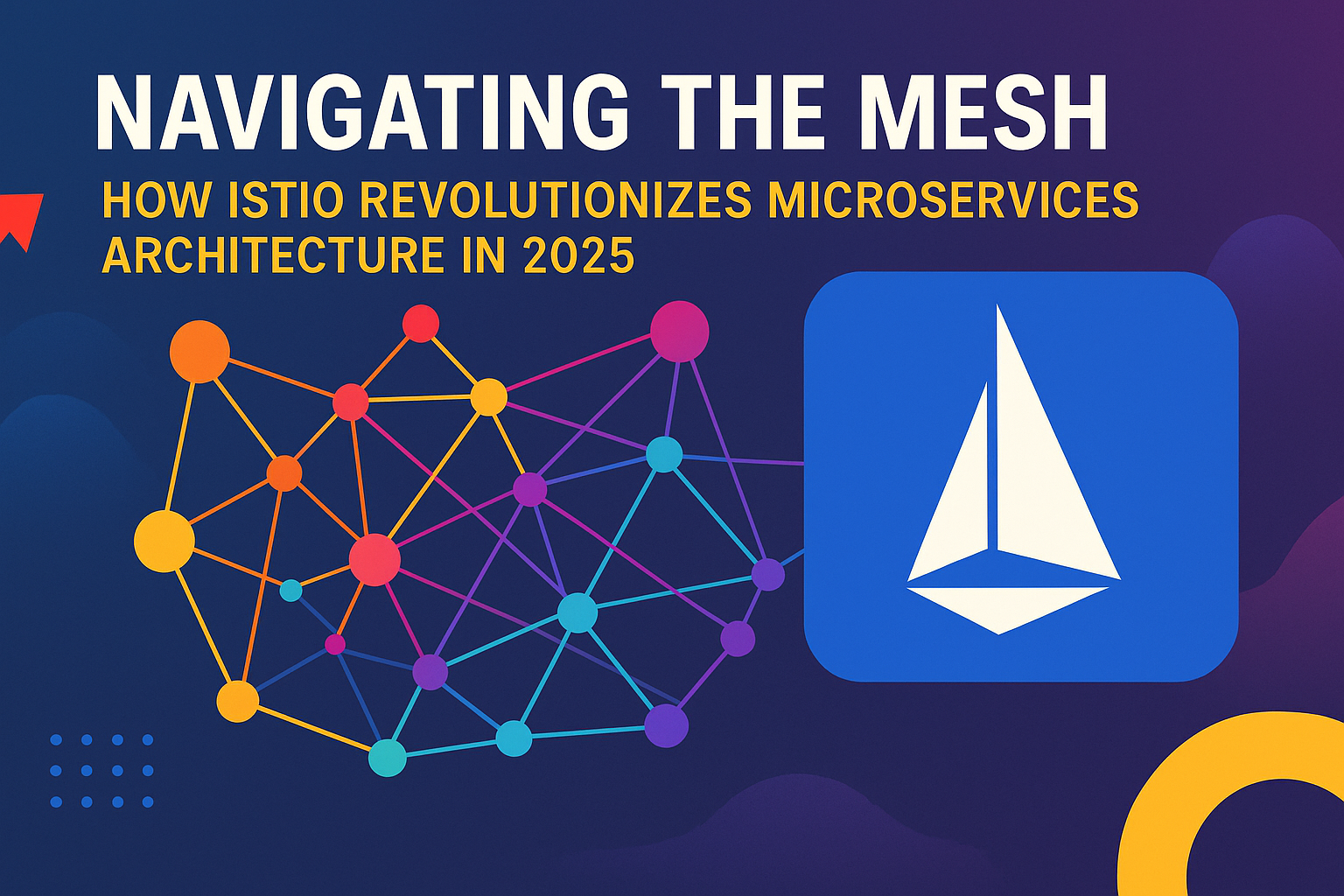Navigating the Mesh: How Istio Revolutionizes Microservices Architecture in 2025
Istio in 2025: enterprise-grade microservice control—zero-trust, deep observability, and traffic mastery in one powerful mesh.

Istio has established itself as the cornerstone of modern service mesh architecture, transforming how organizations manage, secure, and observe their microservices. As we navigate through 2025, this powerful platform continues to evolve, offering sophisticated solutions to the complex challenges of distributed systems. This deep dive explores Istio's architecture, notable successes, security capabilities, and implementation best practices.
The Service Mesh Revolution: Understanding Istio's Foundation
A service mesh functions as an infrastructure layer that equips applications with zero-trust security, observability, and advanced traffic management capabilities without requiring code modifications. Istio, as the leading service mesh solution, was originally developed by Google, IBM, and Lyft in 2016 and has since graduated within the Cloud Native Computing Foundation (CNCF), joining other foundational projects like Kubernetes and Prometheus.
What makes Istio particularly powerful is its ability to function across diverse environments. Whether your services run on Kubernetes, virtual machines, multi-cloud environments, or on-premises infrastructure, Istio can incorporate them within a single mesh. This flexibility addresses a critical challenge in modern enterprise architecture: maintaining workload connectivity and security across heterogeneous platforms.
Architectural Blueprint: Istio's Two-Plane Design
Istio's architecture follows a logical separation that enhances both functionality and manageability:
The Control Plane: The Brain of the Mesh
The control plane serves as the central nervous system of Istio, managing and configuring proxies to orchestrate traffic flow throughout the service mesh. It consists of several key components:
- Pilot: Handles service discovery and configures Envoy sidecar proxies
- Galley: Manages configuration ingestion for Istio components
- Citadel: Provides automated key and certificate management, essential for security functions
- Policy & Telemetry: Enforces policies and collects telemetry data
- Gateway Controllers: Manage inbound and outbound connections to the service mesh
The Data Plane: Where the Action Happens
The data plane comprises a network of intelligent Envoy proxies deployed as sidecars alongside each service instance. These proxies:
- Mediate all network communication between services
- Apply routing rules and traffic management policies
- Enforce security controls like encryption and access limitations
- Collect detailed telemetry data on mesh traffic
The sidecar deployment model is particularly ingenious as it allows organizations to add Istio's capabilities to existing deployments without rearchitecting applications or modifying code. This approach significantly reduces the adoption barrier for enterprises with substantial existing investments.
Real-World Success Stories: Istio in Production
Rappi: Managing Hypergrowth with Istio
Rappi, the Latin American super-app operating in nine countries and over 250 cities, faced significant infrastructure challenges as it grew from a $100 million company to an $8 billion enterprise. Their initial attempt to develop an in-house service mesh proved difficult to maintain as their infrastructure expanded to more than 50 Kubernetes clusters with the largest running over 20,000 containers.
After implementing Istio, Rappi found themselves better equipped to handle their explosive growth. As Ezequiel Arielli, Senior DevOps Engineer at Rappi, noted: "With the Istio service mesh, Rappi has managed to grow as the market requires. They can easily handle deployment of new clusters and turning on services..."
Airbnb's Istio Journey
Airbnb's implementation of Istio represents another compelling case study. In their presentation at IstioCon 2021, Airbnb's Stephen Chan and Weibo He detailed why they needed a modern service mesh and how Istio met their requirements. Notably, Airbnb has stated that "Istio's extensibility, broad feature support and scalability make it a great choice for Airbnb".
Widespread Industry Adoption
Beyond these specific examples, Istio has garnered enthusiastic adoption across various industries. Companies consistently report significant benefits:
- "We've used Istio since 1.3 and we've seen every version become incrementally better. We've seen it become easier to use, use less resources, and get easier to install."
- "Istio deployment is a no-brainer. You install it and it runs."
- "We decided to just try out Istio to see how it would go, and we ended up delivering in the space of about a week – more than we had done in the last four months trying to roll it ourselves."
Security Fortress: Istio's Protection Mechanisms
In an era of increasing cyber threats, Istio's security capabilities have become one of its most valuable aspects.
Zero-Trust Security Model
Istio implements a comprehensive zero-trust security solution based on workload identity, mutual TLS, and strong policy controls. This approach ensures that:
- Services verify the identity of their communication partners
- No service is trusted by default
- All communications must be explicitly permitted
- Communications occur through encrypted channels
Mutual TLS: The Encryption Foundation
Istio automatically configures mutual TLS (mTLS) encryption between services, establishing encrypted communication channels to protect against man-in-the-middle attacks. Though proxies default to "permissive mode" (accepting both mTLS and plaintext), best practices recommend migrating to "strict mode" when possible to enforce mTLS for all service communication.
It's worth noting that different implementations of mTLS can have significant performance implications. Recent technical research comparing Istio, Istio Ambient, Linkerd, and Cilium reveals meaningful differences in latency and memory consumption based on their specific mTLS implementations.
Fine-Grained Authorization
Beyond encryption, Istio provides sophisticated authorization capabilities through powerful policy enforcement mechanisms. Security experts recommend implementing default-deny authorization patterns, where the system denies all requests by default and only explicitly defined conditions permit access.
The implementation of these authorization policies represents a critical part of Istio security, allowing organizations to:
- Define service-to-service access controls
- Limit access based on identity, source, and method
- Create role-based access controls tied to service identity
Implementation Best Practices: Maximizing Istio's Potential
Deployment Strategies
For optimal performance and resilience, consider these deployment recommendations:
-
Deploy fewer, larger clusters: Rather than creating many small clusters, use namespace tenancy to manage large clusters. This approach allows deployment across one or two clusters per region or zone.
-
Geographic proximity to users: Deploy clusters globally to ensure proximity to end-users, reducing latency and improving user experience.
-
Multi-availability zone deployment: Include clusters across multiple availability regions and zones within each geographic region to limit failure domains and prevent global service disruptions.
Security Configuration
To strengthen your Istio implementation's security posture:
-
Migrate to strict mTLS mode: While permissive mode facilitates incremental adoption, strict mode should be the ultimate goal to enforce encryption for all service communication.
-
Implement default-deny authorization: Follow the security principle of least privilege by denying all requests by default and explicitly defining allowed communication paths.
-
Restrict gateway creation privileges: Limit who can create gateways and avoid overly broad host configurations that might expose services unnecessarily.
-
Isolate sensitive services: Implement additional protection layers for services handling sensitive data or critical operations.
Traffic Management Optimization
Istio's traffic management capabilities are powerful but require careful configuration:
-
Implement circuit breakers: Configure circuit breakers to prevent cascading failures when services become overwhelmed.
-
Use canary deployments: Leverage Istio's traffic splitting capabilities for gradual rollouts of new versions.
-
Configure retries and timeouts: Define appropriate retry policies and timeouts to enhance service resilience without overwhelming dependent services.
-
Test network resilience: Use fault injection to simulate network issues and verify your system's resilience to various failure scenarios.
The Evolving Landscape: Istio's Future Trajectory
The service mesh landscape continues to evolve rapidly, with Istio leading much of the innovation. Recent research highlights several emerging trends:
Performance Optimization
Performance overhead has been a traditional concern with service meshes. Recent comparative research between Istio, Istio Ambient, Linkerd, and Cilium shows significant differences in latency and memory consumption, indicating that architecture choices (sidecar versus sidecarless) and implementation details materially impact performance.
Zero Trust Architecture for Control Planes
While service meshes traditionally focus on securing the data plane, research projects like Mazu are now addressing security concerns in the control plane itself. Mazu aims to eliminate trust in the service mesh control plane by replacing its certificate authority with an unprivileged principal, thereby reducing the attack surface while adding minimal request latency (about 0.17ms) compared to mTLS-enabled Istio.
Service Mesh for Edge Computing
Recent qualitative analyses suggest that current service mesh designs, including Istio, may need adaptation to fully address the performance demands of mobile edge cloud workloads. This research motivates further development in performance-efficient architectures, stronger QoS guarantees, and more sophisticated traffic management frameworks.
Managed Mesh Architecture
The concept of managed mesh architecture has emerged as a transformative solution for organizations struggling with service-to-service communication complexity. This approach maintains the benefits of service mesh while reducing operational overhead through managed offerings, making Istio capabilities more accessible to organizations with limited operational resources.
Beyond the Mesh: What's Next for Istio
As Istio matures, we're witnessing its expansion into new domains and use cases. The architecture's inherent flexibility, extensibility, and community support position it well to address emerging challenges in distributed systems management.
Organizations implementing Istio today should focus on mastering core capabilities while keeping an eye on evolving features and best practices. The journey toward fully leveraging Istio's potential is continuous, requiring ongoing learning and adaptation.
The service mesh paradigm, with Istio at its forefront, represents not just a technical solution but a fundamental shift in how we approach distributed systems architecture. By abstracting complex networking concerns into a dedicated infrastructure layer, Istio empowers developers to focus on business logic while operations teams gain unprecedented visibility and control over service interactions.
For organizations navigating the complexities of cloud-native architecture in 2025, Istio offers a battle-tested path forward-one that continues to evolve alongside the ever-changing landscape of distributed systems.

